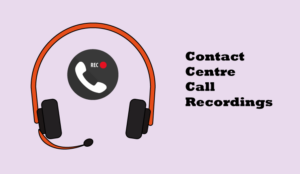Rachael Royds of CallMiner discusses how call recordings can be paired with speech analytics technology to improve contact centre performance.
According to a recent survey of contact centre professionals by Contact Babel, over 90% of businesses record their calls, but only 34% are analysing them with a speech analytics solution.
Even with 21% saying they were looking to implement a solution this year, this is leaving a lot of customer and agent insight data wasting away.
Below are four ways that your call recordings can be paired with speech analytics to improve your contact centre performance.
1. Quality Monitoring Processes
One of the most common uses of call recordings is for quality monitoring purposes. However, traditional quality assurance (QA) processes, some in the form of manual checklists, only manage to use about 1–2% of agents’ monthly calls for that purpose.
This means that all the wealth of data hidden in those recordings remains overlooked, making it virtually impossible for managers to get a true sense of the quality of performance of each individual agent.
To utilise your call recordings in the most efficient way you can, use tools such as speech analytics to automatically analyse and score 100% of recordings. This will enable you to deliver automated performance feedback to agents and supervisors, and necessary insights to manage any quality assurance processes more efficiently.
By utilising recordings in this way, companies can categorise their calls and search for trends in customer behavior (e.g. uncovering the root cause of customer complaints and eliminate the source), ultimately raising the quality of service provided to customers.
In my opinion, if call recordings are used for QA purposes, then it is a very high-risk strategy to base QA decisions on anything less than 100% of calls.
2. Identifying Customer Trends and Sales Opportunities
Your call recordings can be used to identify customer trends or sales opportunities. To perform trend analysis, you need to be able to analyse and score 100% of your call recordings. You can then identify and correlate desired outcomes of the calls, such as driving successful sales, with certain agent behaviours, skills or language used.
Therefore, if you analyse your call recordings with speech analytics, you can identify different ways of making a sale and select the one with the best outcome to create an optimum path.
Agents testing this path can be scored against adherence to the desired script or their ability to identify language which indicates a willingness to buy.
3. Ensuring Compliance
Failing to comply with regulations can be incredibly costly – both to your company’s bottom line and reputation. Call recordings can help drive the right kind of compliant behaviour. But manual sampling of recorded calls provides little to no prevention of non-compliant behaviour or protection against litigation. This presents a huge risk to the call centre.
Instead, you should consider utilising your call recordings in a way that will enhance your continuous monitoring capabilities by tracking every conversation to ensure that the right compliance procedures are in place.
Speech analytics or interaction analytics across channels can help by analysing and scoring every single agent interaction, either during or after the call, as opposed to traditional random compliance checks.
The result is lower cost and effort in call centre quality monitoring. This can drive better compliance adherence, streamline auditing and, ultimately, reduce/eliminate possible fines or lawsuits for non-compliance.
4. Improving Coaching and Training
Call recordings contain a huge amount of information that can be incredibly useful for coaching and training purposes. However, this insight is often not fully utilised as the manual process of listening to agent calls is very time consuming.
This manual approach is also not fair because agent performance is being assessed based on a very thin slice of their calls. As a result, it is often not possible to arrive at a fair assessment of an agent’s coaching and training needs.
To overcome these weaknesses and use your call recordings to drive smarter training and coaching, you can use call analytics to identify individual coaching and training needs.
This analysis can also provide agents with actionable information they can use to improve their own performance and quality scores. Because the insight is based on 100% of their calls, it will produce much fairer performance feedback.
As a result, agents are more likely to embrace the coaching and training because they can see how it will help their performance. This positive mindset can help to create a culture of self-improvement and continuous improvement.
This blog post has been re-published by kind permission of CallMiner – View the Original Article
For more information about CallMiner - visit the CallMiner Website
Author: CallMiner
Published On: 31st May 2019 - Last modified: 26th Feb 2025
Read more about - Expert Insights, Analytics, Call Recording, CallMiner, Performance Management






 CallMiner is the leading cloud-based customer interaction analytics solution for extracting business intelligence and improving agent performance across all contact channels.
CallMiner is the leading cloud-based customer interaction analytics solution for extracting business intelligence and improving agent performance across all contact channels. 


































